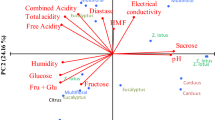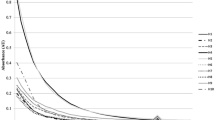Abstract
Honey from different botanical sources presents a great variability in chemical composition, physical properties, and sensorial attributes. The association between honey qualities and its geographical origin allows the recognition of honey, and beekeepers are economically benefited. The objective of this study was to evaluate the physicochemical characteristics of honey produced in Ortigueira, Brazil and to compare it with the honey produced in the neighboring localities for the request of geographical indication certification. In the 112 honey samples collected between 2010 and 2013 from Ortigueira and the neighboring localities, moisture acidity, pH, hydroxymethyl furfural (HMF), diastase activity (DA), sugars, proline (Pro), electrical conductivity (EC), color absorbance at 635 nm (C635), and Cielab color parameters were evaluated. HMF, reducing sugars (RS), total sugars (TS), proline, and color parameters (L*, a* and b*) were significantly different in Ortigueira 2010 honey seasons. Principal component analysis separated assapeixe (Vernonia sp) and capixingui (Croton floribundus) honeys from wild honeys (polyfloral). In addition, HMF, RS, L*, and lactonic acidity values promoted the separation between assapeixe and capixingui honeys. Ortigueira honey differs significantly from honeys from neighboring locality in pH, proline, HMF, DA, EC, RS, sucrose, TS, free and total acidity, and color parameters (C635, L*, a*, b*). The multivariate analysis applied to variables was efficient to discriminate honeys from different botanical sources and different locals, and is recommended for studies on the geographical indication of honey.



Similar content being viewed by others
References
Acquarone C, Buera P, Elizalde B (2007) Pattern of pH and electrical conductivity upon honey dilution as a complementary tool for discriminating geographical origin of honeys. Food Chem 101(2):695–703
Addinsoft (2010) XLStat: software for statistical analysis. Version 2010. Paris. 1 CD-ROM
Alves EM, Sereia MJ, Toledo VAA, Marchini LM, Neves CA, Toledo TCSOA, Almeida-Anacleto D (2011) Physicochemical characteristics of organic honey samples of africanized honeybees from Parana River islands. Food Sci Technol 31(3):635–639
Ananias KR, Melo AAM, Moura CJ (2013) Analysis of moisture content, acidity and contamination by yeast and molds in Apis mellifera L. honey from central Brazil. Braz J Microbiol 44(3):679–683.
AOAC (1990) Official methods of analysis, 15th edn. Association of Official Analytical Chemists, Washington
Baroni MV, Arrua C, Nores ML, Fayé P, Díaz MP, Chiabrando GA, Wunderlin DA (2009) Composition of honey from Córdoba (Argentina): assessment of north/south provenance by chemometrics. Food Chem 114(2):727–733
Barra MPG, Ponce-Díaz MC, Venegas-Gallegos C (2010) Volatile compounds in honey produced in the central valley of Ñuble province Chile. Chilean J Agric Res 70(1):75–84
Barros LB, Torres FR, Azeredo LC, Barth MO, Freitas MQ (2010) Physicochemical characterization of honey produced by Apis mellifera in the state of Rio de Janeiro. Rev Bras Ci Vet 17(3/4):117–120
Barth MO, Maiorino C, Benatti APT, Bastos DHM (2005) Determinação de parâmetros físico-químicos e da origem botânica de méis indicados monoflorais do sudeste do Brasil Cienc Tecnol Alime 25(2):229–233
Belleti G, Marescotti A, Paus M, Reviron S, Deppeler A, Stamm H, Thévenod-Mottet E The effects of protecting geographical indications-Ways and means of their evaluation. Swiss Federal Institute of Intellectual Property, Publication No 7; 2 revised edition, 09.11 https://www.ige.ch. Accessed 4 Apr 2014
Bogdanov S (2009) Harmonised Methods of the International Honey Commission. https://www.bee-hexagon.net/en/network.htm. Accessed 05/05/2010
Borsato DM, Farago PV, Fernandes CPL, Alencar MS, Mendes MA (2014) Physicochemical quality, botanical origin and antioxidant properties of floral honeys from Campos Gerais region Brazil. Interciencia 39(4):249–254
Carratù B, Ciarrocchi M, Mosca M, Sanzini E (2011) Free amino acids, oxalate and sulphate for honey characterization. J ApiProd ApiMed Sci 3(2):81–88
Carvalho CAL, Sodré GS, Fonseca AAO, Alves RMO, Souza BA, Clarton L (2009) Physicochemical characteristics and sensory profile of honey samples from stingless bees (Apidae: Melliponinae) submitted to dehumidification process. An Acad Bras Cienc 81(1):143–149
Castro-Vázquez L, Díaz-Maroto MC, González-Viñas M, De La Fuente AE, Pérez-Coello MS (2008) Influence of storage conditions on chemical composition and sensory properties of citrus honey. J Agric Food Chem 56(6):1999–2006
Devillers J, Morlot M, Pham-Delègue MH, Dore JC (2004) Classification of monofloral honeys based on their quality control data. Food Chem 86(2):305–312
Ferreira ICFR, Aires E, Barreira JCM, Estevinho LM (2009) Antioxidant activity of Portuguese honey samples: different contributions of the entire honey and phenolic extract. Food Chem 114(4):1438–1443
González-Miret ML, Terrab A, Hernanz D, Fernández-Recamales MA, Heredia FJ (2005) Multivariate correlation between color and mineral composition of honeys and by their botanical origin. J Agric Food Chem 53(7):2574–2580
Hermosin I, Chicon RM, Cabezudo MD (2003) Free amino acid composition and botanical origin of honey. Food Chem 83(2):263–268
Iglesias A, Feás X, Rodrigues S, Seijas JA, Vázquez-Tato MP, Dias LG, Estevinho ML (2012) Comprehensive study of honey with protected denomination of origin and contribution to the enhancement of legal specifications. Molecules 17:8561–8577
Janiszewska K, Aniołowska M, Nowakowski P (2012) Free amino acids content of honeys from Poland. Pol J Food Nutr Sci 62(1):85–89
Kadar M, Juan-Borrás M, Hellebrandova M, Domenech E, Escriche I (2010) Differentiation of acacia, sunflower and tilia honeys from different countries based on sugar composition, physicochemical and color parameters. Bull USAMV Agric. 67(2):252–258
Kaskoniene V, Venskutonis PR (2010) Floral markers in honey of various botanical and geographical origins: a review. Compr Rev Food Sci F 9:620–634
Lacerda JJJ, Santos JS, Santos SA, Rodrigues GB, Santos MLP (2010) Influência das características físico-químicas e composição elementar nas cores de méis produzidos por Apis mellifera no sudoeste da Bahia utilizando análise multivariada. Quim Nova 33(5):1022–1026
Marchini LC, Moreti ACCC, Otsuk IP, Sodré GS (2007) Physicochemical composition of Apis mellifera honey samples from São Paulo State Brazil. Quim Nova 30(7):1653–1657
Mato I, Huidobro JF, Simal-Lozano J, Sancho MT (2003) Significance of nonaromatic organic acids in honey. Food Protec 66(12):2371–2376
Mondragón-Cortez P, Ulloa JA, Rosas-Ulloa P, Rodríguez-Rodríguez R, Resendiz-Vázquez JA (2013) Physicochemical characterization of honey from the West region of México. CyTA-J Food 11(1):7–13
Pérez-Pérez E, Vit P, Rivas E, Sciortino R, Sosa A, Tejada D, Rodríguez-Malaver AJ (2012) Antioxidant activity of four color fractions of bee pollen from Mérida Venezuela. Arch Latinoam Nutr 62(4):375–380
Silva PM, Gouche C, Gonzaga LV, Costa ACO, Feet R (2016) Honey: chemical composition, stability and authenticity. Food Chem 196(4):309–323
Stolzenbach S, Byrne VB, Bredie LP (2011) Sensory local uniqueness of Danish honeys. Food Res Int 44(9):2766–2774
Terrab A, Dıez MJ, Heredia FJ (2002) Chromatic characterisation of Moroc can honeys by diffuse reflectance and tristimulus colorimetry—non-uniform and uniform colour spaces. Food Sci Tech Int 8(4):189–195
Terrab A, Recamale AF, Hernanz D, Heredia FJ (2004) Characterization of Spanish thyme honeys by their physicochemical characteristics and mineral contents. Food Chem 88(4):537–542
Tuberoso CIG, Jerkovic I, Sarais G, Congiu F, Marijanovic Z, Kus PM (2014) Color evaluation of seventeen European unifloral honey types by means of spectrophotometrically determined L*C*abH°ab chromaticity coordinates. Food Chem 145(2):284–291
Viúda-Martos M, Ruiz-Navajas Y, Zaldivar-Cruz JM, Kuri V, Fernández-López J, Carbonell-Barrachina AA, Pérez-Álvarez JA (2010) Aroma profile and physico-chemical properties of artisanal honey from Tabasco Mexico. Int J Food Sci Tech 45(6):1111–1118
Welke JE, Reginatto S, Ferreira D, Vicenzi R, Soares JM (2008) Caracterização físico-química de méis de Apis mellifera L. da região Noroeste do estado do Rio Grande do Sul. Ciên Rur 36(6):1737–1741
Woodcock T, Downey G, Kelly JD, O’Donnell C (2007) Geographical classification of honey samples by near-infrared spectroscopy: a feasibility study. J Agric Food Chem 55(22):9128–9134
Acknowledgements
The authors would like to thank the Secretaria de Estado de Ciência, Tecnologia e Ensino Superior—SETI (TC 30/10), and Fundação Araucária de Apoio ao Desenvolvimento Científico e Tecnológico for financial suportes. We also thank beekeepers who kindly provide the honey samples for the study.
Author information
Authors and Affiliations
Corresponding author
Ethics declarations
Conflict of interest
The authors declare that do not have any conflicts of interest.
Additional information
Publisher's Note
Springer Nature remains neutral with regard to jurisdictional claims in published maps and institutional affiliations.
Electronic supplementary material
Below is the link to the electronic supplementary material.
Rights and permissions
About this article
Cite this article
Scholz, M.B.S., Quinhone Júnior, A., Delamuta, B.H. et al. Indication of the geographical origin of honey using its physicochemical characteristics and multivariate analysis. J Food Sci Technol 57, 1896–1903 (2020). https://doi.org/10.1007/s13197-019-04225-3
Revised:
Accepted:
Published:
Issue Date:
DOI: https://doi.org/10.1007/s13197-019-04225-3




